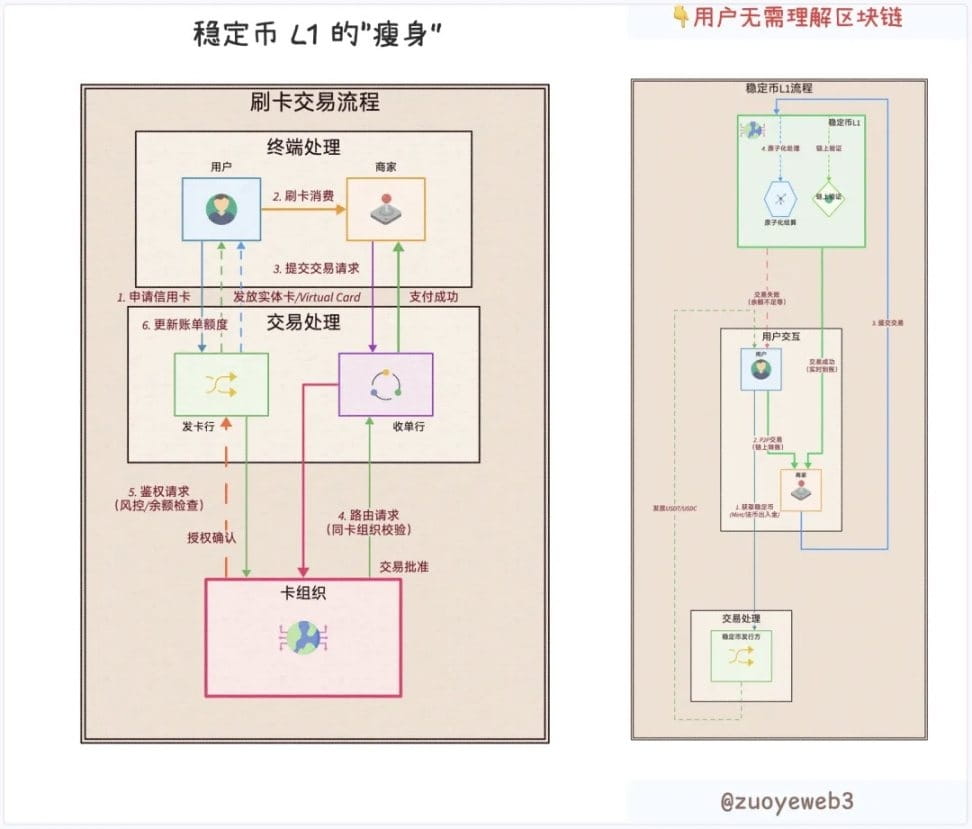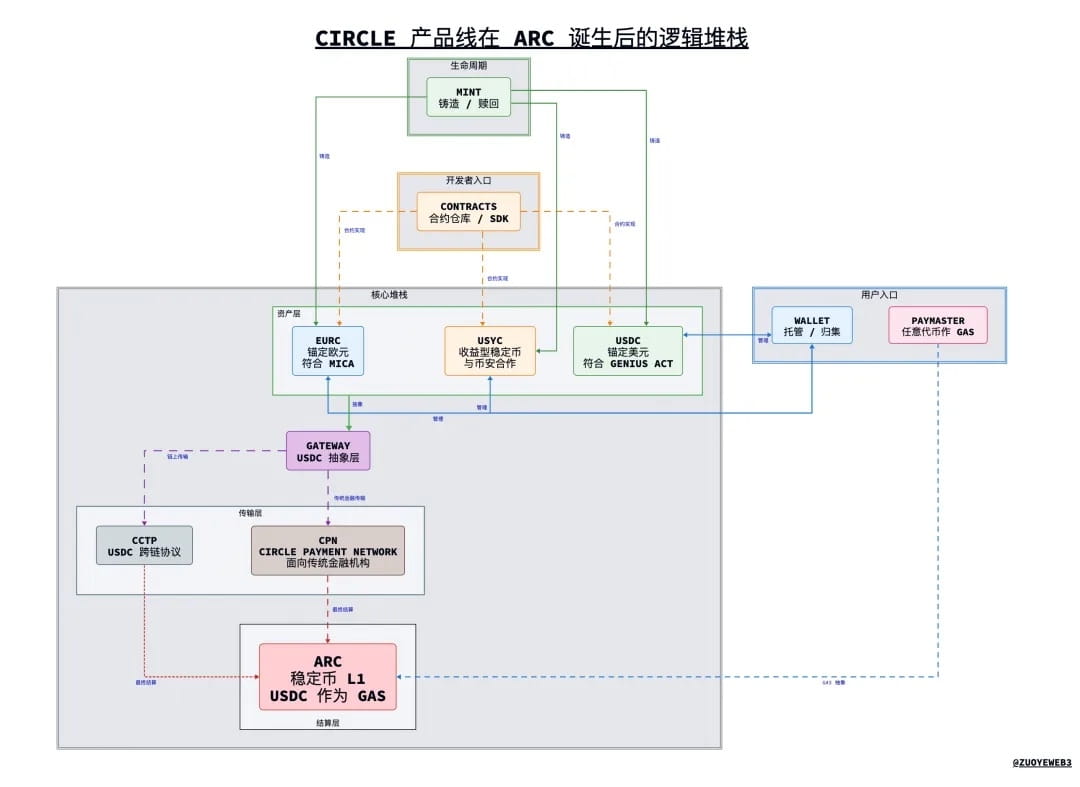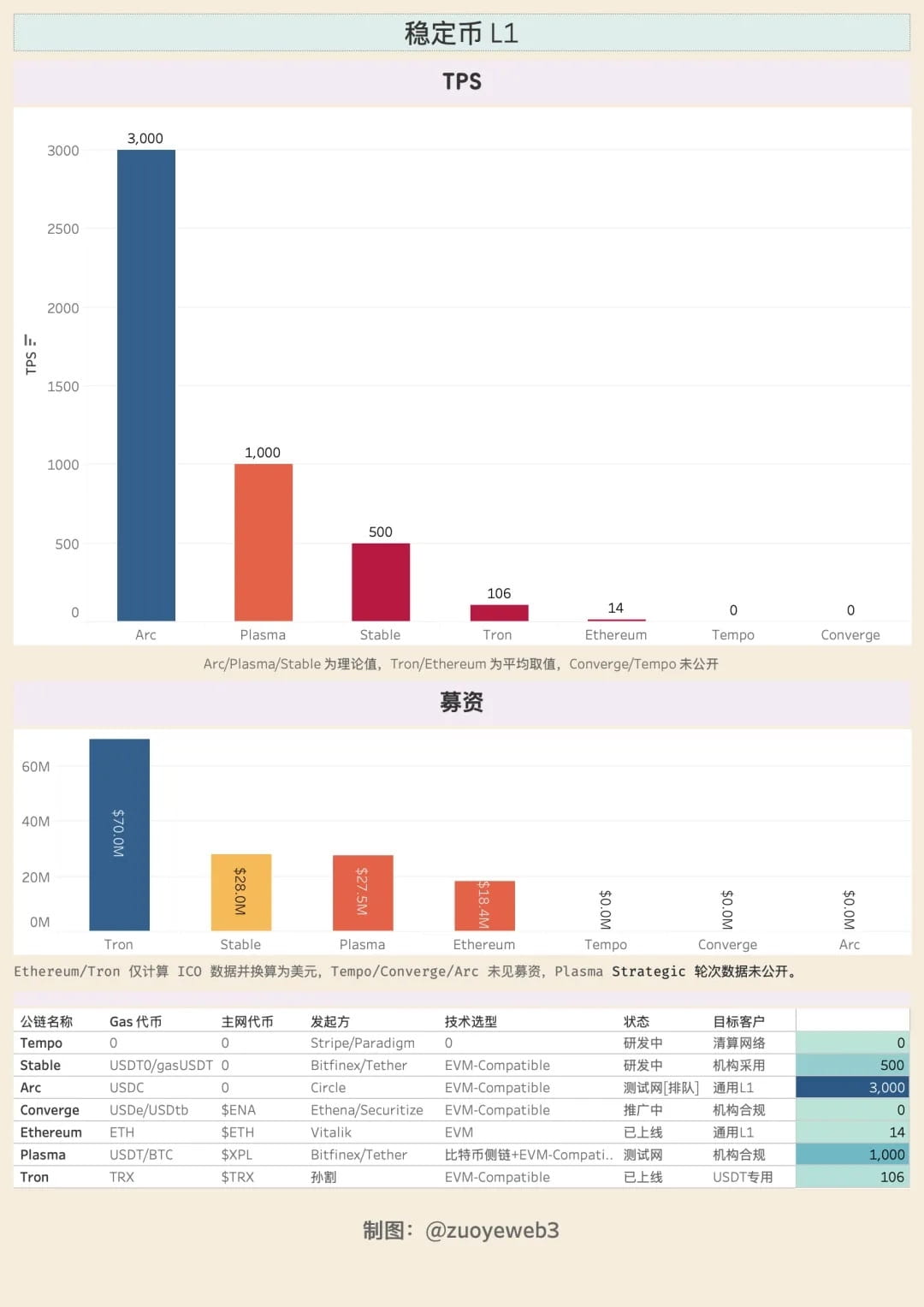Written by: Zuoye
Software eats the world, and stablecoins eat blockchain.
This time it's not Coinbase's Base or Robinhood L2. Circle and Stripe have almost simultaneously chosen to build their own stablecoin Layer 1, completely breaking free from the constraints of existing public chains, reconstructing everything from the underlying mechanism to the Gas token around stablecoins.
The banks have lost their deer; stablecoins are chasing it.
On the surface, Circle's Arc and Stripe's Tempo directly compete with Tron and Ethereum, but in reality, they are targeting the global clearing power of the 'post-central bank - banking system'. The Visa and SWIFT systems that support fiat currencies can no longer meet the global liquidity needs of stablecoins.
Cross-industry crisis: Card organizations give way to stablecoin public chains.
The Wintel alliance monopolized the personal PC market for nearly 30 years, until the ARM system rose in the mobile sector, leading Intel to decline gradually without making mistakes.
Bank cards and card organizations are not synchronized. The first card organization, Diners Club, established a credit accounting system for restaurants and 'loyal fans' in 1950. Loyalty became the precursor to credit and points systems, and it wasn't until the 1960s that it connected with the banking industry. Starting from credit cards, local banks in the U.S. broke state and national boundaries and eventually swept the globe.
Compared to banks that need to swing periodically around leverage under the command of the Federal Reserve, card organizations like Visa/MasterCard operate a cash flow business that is a sure thing. For example, in 2024, Capital One acquired Discover for $35.3 billion, transforming into a giant organization that combines card issuing and card organization.
The integration of traditional banks is precisely the precursor to stablecoin issuance in the stablecoin public chain. Only integration can grasp all channels of issuance, distribution, and payment collection.
After the Genius Act, the operating logic of the U.S. dollar has completely changed. Traditional commercial banks bear the responsibility of credit creation and currency issuance (M0/M1/M2), but Tether and Circle's U.S. Treasury positions have already surpassed multiple national entities.
Stablecoins connect directly to government bonds. The banking industry can issue stablecoins for self-rescue, but card organizations and cross-border payment channels face survival crises.
• Banking industry -> Stablecoin issuers USDT, USDC.
• Card organizations / SWIFT / PSP -> Stablecoin L1.
In traditional trading flows, users, merchants, issuing institutions, acquiring institutions, and card organizations are completely different roles. However, blockchain's programmability fundamentally changes this, allowing any role to be reduced to 'user'. Whether it's the privacy treasury and confidential transfers needed by institutions or the convenience needed by individuals, it's just a matter of distinguishing different codes.
Stablecoin L1 directly eliminates the necessity of any non-user institutions. Only users, stablecoins, and L1 are needed to complete any role and function exchange and stacking, even for compliance reviews by regulatory authorities.

Image description: Innovation in transaction processes.
Image source: @zuoyeweb3
Of course, this doesn't mean that specialized issuance and technical service institutions will disappear. Rather, from a co-coupled code perspective, suppliers can be reviewed and selected. For instance, in the case of U cards, the profits from virtual cards are taken by upstream providers, leaving the U card issuers themselves with losses.
Technological innovation is the precursor to the change in organizational relationships.
Now it's enough to build a Visa from scratch; all profits can be kept to distribute to users.
Like Capital One, before acquiring Discover, they needed to pay Visa/MasterCard a fee of 1.5%. USDT/USDC also needs to pay Gas Fees to Tron and Ethereum.
Just as Circle promotes Arc, Coinbase Commerce directly connects with Shopify, and Circle has also chosen Binance as its partner for the yield-bearing stablecoin USYC.
Tether once claimed that 40% of public chain fees are generated by it, and Circle even has to give Coinbase an additional 'subsidy' of $300 million per quarter. Therefore, it is reasonable to establish its own distribution channels and end networks by eliminating existing channel providers.
However, Circle chooses to build independently, while Tether opts for external racing with Plasma and Stable.
The only exception is Stripe. Stripe lacks stablecoins, but controls the end-user network. After acquiring Bridge and Privy, it has completed a technical closed loop. Boldly predicting, Stripe will eventually issue or 'support' its own stablecoin.
In summary, the issuance, distribution channels, and end networks of stablecoins are all building their own closed loops.
• Stablecoin issuers: Circle's Arc, Tether's Plasma and Stable, USDe's Converge.
• Distribution Channels: Exchanges like Coinbase, Binance, and existing public chains like Ethereum and Tron.
• End Network: Stripe builds its own Tempo.
The freedom of the French is not the same as the freedom of the British. USDT's L1 is not the habitat of USDC. When everyone no longer wants to make do with life, the competition between existing public chains and card organizations flows like the Yangtze River, unstoppable.
Technology diffusion: Public chains can easily attract institutional clients but struggle to expand.
Extremely defending freedom is not evil, and converging pursuit of justice is not virtue.
Privacy is no longer a concern for ordinary users. Just like QUBIC's whale swallowing of Monero can't compare to the heat of treasury strategies, privacy transactions from a libertarian perspective are merely 'paid privileges' for institutional users. Ordinary users are truly concerned about transaction fees.
Before issuing Arc, Circle's product line had already diversified, even becoming somewhat complex. It is under the unified reorganization of Arc that synergistic effects may be realized, allowing USDC to escape the awkward position of being an affiliate of Coinbase.

Image description: Logic stack of Circle's product line after the birth of Arc.
Image source: @zuoyeweb3
Taking Arc as an example, one can glimpse the future technological architecture of stablecoin public chains. It should be noted that the above is only a personal understanding of the logical architecture and does not necessarily represent the reality (universal disclaimer).
1. Product Description
• USDC/EURC/USYC: Circle's three main stablecoin product lines. USDC is pegged to the U.S. dollar and complies with the Genius Act regulations, EURC is pegged to the euro and complies with the MiCA regulations, and USYC is an interest-bearing stablecoin, with USYC partnering with Binance.
• CPN (Circle Payment Network): A cross-border clearing network initiated by Circle based on USDC, similar to SWIFT.
• Mint: Users can mint stablecoins like USDC here.
• Circle Wallet: Personal and institutional users can manage various Circle stablecoins here.
• Contracts: Contracts for stablecoins like USDC written by Circle.
• CCTP: USDC cross-chain technology standard.
• GateWay: The abstract layer of USDC, where users do not need to know the underlying public chain and technical details, and gain direct interaction experience with USDC.
• Paymaster allows any token to serve as a Gas token.
• Arc: Stablecoin Layer 1 initiated by Circle, with USDC as the native Gas Token.
2. Logic Stack
• The main part: From top to bottom divided into: USDC/EURC/USYC -> Gateway -> CCTP/CPN in parallel. CCTP is mainly used on-chain, while CPN is mainly promoted in traditional financial institutions -> Arc.
• Consider the main part as a whole: Mint is the recharge entry, Wallet is the fund aggregation entry, Contracts are the programming entry, and Paymaster is the accompanying function, allowing any token to be used as a Gas token.
Under a mechanism named PoS, which is essentially DPOS, Arc can theoretically achieve 3000 TPS with a maximum of 20 nodes and sub-second transaction confirmation times. The Gas Fee can even be as low as below $1, and it thoughtfully prepares privacy transfers and treasury modes for institutions, ready to accommodate large-scale enterprise funds on-chain. This may also be an important reason for Circle to build its own L1; beyond stablecoin trading and transfers, enterprise asset management is also a key area of competition.
Moreover, the universal L1 architecture reserves interfaces and full-function architecture for more assets like RWA to go on-chain. Malachite, transformed from CometBFT developed by Informal Systems, theoretically has the potential for 50,000 TPS.
Next comes the familiar EVM compatibility, MEV protection, FX (foreign exchange) engine, and trading optimization. One can say that with the support of Cosmos, launching Hyperliquid-level products technically has no bottlenecks, and if it's L2, the difficulty won't exceed deploying Docker instances.
In Arc's plans, cryptographic technologies like TEE/ZK/FHE/MPC will all be integrated. One can say that today's technology diffusion makes the start-up cost of public chains incredibly close to a constant. What is rare is ecological expansion. It took Visa 50 years to build distribution channels and end networks, while the USDT/Tron alliance took 8 years, and Tether has been established for 11 years.
Time is the greatest enemy of stablecoin L1, so stablecoins have chosen a strategy of separating saying from doing:
• Do: Retail users use - 'distribution channels -> institutional adoption.
• Say: Institutional compliance - 'mass adoption
Whether it's Tempo or Converge, both target institutional adoption, and Arc is focused on promoting a globally compliant path. Compliance + institutions is the go-to-market strategy for stablecoin L1, but this is not the whole story; stablecoin L1 will promote in a more 'Crypto' way.
Plasma and Converge are both collaborating with Pendle. Circle is subtly promoting the yield stablecoins USYC and USDC's 24/7 exchange. Tempo is led by Paradigm founder Matt Huang, and the core is to be more blockchain-centric rather than more Fintech-centric.
Institutional adoption has always been a compliance measure. Just like Meta claims to protect user privacy, in real business, there must first be users to drive institutional adoption. Don't forget that USDT's earliest and largest user group has always been ordinary people in Asia, Africa, and Latin America, who have now also entered the institutional spotlight.
Distribution channels have never been the forte of institutions; the ground promotion army is the true essence of the internet.

Image description: Comparison of Stablecoin L1.
Image source: @zuoyeweb3
Emerging stablecoin L1 either raises a lot of funds or relies on strong backing. Under the Genius Act and MiCA regulations, it is generally not allowed to pay interest to users and cannot use this to attract customers. However, USDe has relied on circulating loans to reach a volume of $10 billion within a month.
The gap between on-chain yield distribution and user conversion leaves market space for interest-bearing stablecoins. USDe is on-chain, while USDtb, with the support of Anchorage, has become a compliant stablecoin under the Genius Act.
Profits can greatly promote user adoption, which is a deadly temptation. Beyond the boundaries defined by rules, is a good battleground for each to showcase their talents.
Conclusion
Before stablecoin L1, TRC-20 USDT was effectively the global USDT clearing network, and USDT is the only stablecoin with real users, so Tether does not need to share profits with exchanges. USDC is merely its compliant substitute, just as Coinbase is a reflection of Binance on NASDAQ.
Stablecoin L1 is challenging Visa and Ethereum; the global currency circulation system is fundamentally being reshaped. The global adoption rate of the U.S. dollar is gradually declining, but stablecoin L1 has already targeted foreign exchange trading. The market is always right, and stablecoins aspire to do more.
After more than 10 years since the birth of blockchain, seeing innovation in the public chain field is already enough to be gratifying. Perhaps the most fortunate thing is that Web3 is not Fintech 2.0; DeFi is also changing CeFi|TradiFi, and stablecoins are changing banks (deposits / cross-border payments).
Hope that stablecoin L1 continues to inherit the core concept of blockchain.


